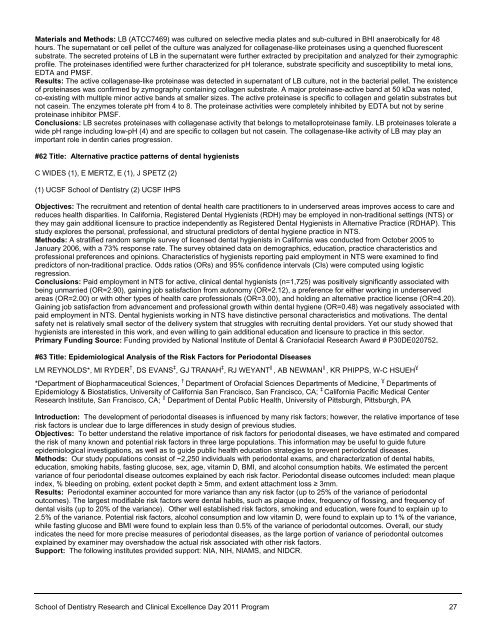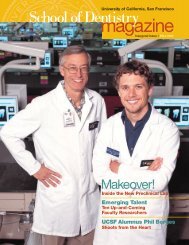Acknowledgements - UCSF School of Dentistry - University of ...
Acknowledgements - UCSF School of Dentistry - University of ...
Acknowledgements - UCSF School of Dentistry - University of ...
Create successful ePaper yourself
Turn your PDF publications into a flip-book with our unique Google optimized e-Paper software.
Materials and Methods: LB (ATCC7469) was cultured on selective media plates and sub-cultured in BHI anaerobically for 48<br />
hours. The supernatant or cell pellet <strong>of</strong> the culture was analyzed for collagenase-like proteinases using a quenched fluorescent<br />
substrate. The secreted proteins <strong>of</strong> LB in the supernatant were further extracted by precipitation and analyzed for their zymographic<br />
pr<strong>of</strong>ile. The proteinases identified were further characterized for pH tolerance, substrate specificity and susceptibility to metal ions,<br />
EDTA and PMSF.<br />
Results: The active collagenase-like proteinase was detected in supernatant <strong>of</strong> LB culture, not in the bacterial pellet. The existence<br />
<strong>of</strong> proteinases was confirmed by zymography containing collagen substrate. A major proteinase-active band at 50 kDa was noted,<br />
co-existing with multiple minor active bands at smaller sizes. The active proteinase is specific to collagen and gelatin substrates but<br />
not casein. The enzymes tolerate pH from 4 to 8. The proteinase activities were completely inhibited by EDTA but not by serine<br />
proteinase inhibitor PMSF.<br />
Conclusions: LB secretes proteinases with collagenase activity that belongs to metalloproteinase family. LB proteinases tolerate a<br />
wide pH range including low-pH (4) and are specific to collagen but not casein. The collagenase-like activity <strong>of</strong> LB may play an<br />
important role in dentin caries progression.<br />
#62 Title: Alternative practice patterns <strong>of</strong> dental hygienists<br />
C WIDES (1), E MERTZ, E (1), J SPETZ (2)<br />
(1) <strong>UCSF</strong> <strong>School</strong> <strong>of</strong> <strong>Dentistry</strong> (2) <strong>UCSF</strong> IHPS<br />
Objectives: The recruitment and retention <strong>of</strong> dental health care practitioners to in underserved areas improves access to care and<br />
reduces health disparities. In California, Registered Dental Hygienists (RDH) may be employed in non-traditional settings (NTS) or<br />
they may gain additional licensure to practice independently as Registered Dental Hygienists in Alternative Practice (RDHAP). This<br />
study explores the personal, pr<strong>of</strong>essional, and structural predictors <strong>of</strong> dental hygiene practice in NTS.<br />
Methods: A stratified random sample survey <strong>of</strong> licensed dental hygienists in California was conducted from October 2005 to<br />
January 2006, with a 73% response rate. The survey obtained data on demographics, education, practice characteristics and<br />
pr<strong>of</strong>essional preferences and opinions. Characteristics <strong>of</strong> hygienists reporting paid employment in NTS were examined to find<br />
predictors <strong>of</strong> non-traditional practice. Odds ratios (ORs) and 95% confidence intervals (CIs) were computed using logistic<br />
regression.<br />
Conclusions: Paid employment in NTS for active, clinical dental hygienists (n=1,725) was positively significantly associated with<br />
being unmarried (OR=2.90), gaining job satisfaction from autonomy (OR=2.12), a preference for either working in underserved<br />
areas (OR=2.00) or with other types <strong>of</strong> health care pr<strong>of</strong>essionals (OR=3.00), and holding an alternative practice license (OR=4.20).<br />
Gaining job satisfaction from advancement and pr<strong>of</strong>essional growth within dental hygiene (OR=0.48) was negatively associated with<br />
paid employment in NTS. Dental hygienists working in NTS have distinctive personal characteristics and motivations. The dental<br />
safety net is relatively small sector <strong>of</strong> the delivery system that struggles with recruiting dental providers. Yet our study showed that<br />
hygienists are interested in this work, and even willing to gain additional education and licensure to practice in this sector.<br />
Primary Funding Source: Funding provided by National Institute <strong>of</strong> Dental & Crani<strong>of</strong>acial Research Award # P30DE020752.<br />
#63 Title: Epidemiological Analysis <strong>of</strong> the Risk Factors for Periodontal Diseases<br />
LM REYNOLDS*, MI RYDER † , DS EVANS ‡ , GJ TRANAH ‡ , RJ WEYANT ‖ , AB NEWMAN ‖ , KR PHIPPS, W-C HSUEH Ɣ<br />
*Department <strong>of</strong> Biopharmaceutical Sciences, † Department <strong>of</strong> Or<strong>of</strong>acial Sciences Departments <strong>of</strong> Medicine, Ɣ Departments <strong>of</strong><br />
Epidemiology & Biostatistics, <strong>University</strong> <strong>of</strong> California San Francisco, San Francisco, CA; ‡ California Pacific Medical Center<br />
Research Institute, San Francisco, CA; ‖ Department <strong>of</strong> Dental Public Health, <strong>University</strong> <strong>of</strong> Pittsburgh, Pittsburgh, PA<br />
Introduction: The development <strong>of</strong> periodontal diseases is influenced by many risk factors; however, the relative importance <strong>of</strong> tese<br />
risk factors is unclear due to large differences in study design <strong>of</strong> previous studies.<br />
Objectives: To better understand the relative importance <strong>of</strong> risk factors for periodontal diseases, we have estimated and compared<br />
the risk <strong>of</strong> many known and potential risk factors in three large populations. This information may be useful to guide future<br />
epidemiological investigations, as well as to guide public health education strategies to prevent periodontal diseases.<br />
Methods: Our study populations consist <strong>of</strong> ~2,250 individuals with periodontal exams, and characterization <strong>of</strong> dental habits,<br />
education, smoking habits, fasting glucose, sex, age, vitamin D, BMI, and alcohol consumption habits. We estimated the percent<br />
variance <strong>of</strong> four periodontal disease outcomes explained by each risk factor. Periodontal disease outcomes included: mean plaque<br />
index, % bleeding on probing, extent pocket depth ≥ 5mm, and extent attachment loss ≥ 3mm.<br />
Results: Periodontal examiner accounted for more variance than any risk factor (up to 25% <strong>of</strong> the variance <strong>of</strong> periodontal<br />
outcomes). The largest modifiable risk factors were dental habits, such as plaque index, frequency <strong>of</strong> flossing, and frequency <strong>of</strong><br />
dental visits (up to 20% <strong>of</strong> the variance). Other well established risk factors, smoking and education, were found to explain up to<br />
2.5% <strong>of</strong> the variance. Potential risk factors, alcohol consumption and low vitamin D, were found to explain up to 1% <strong>of</strong> the variance,<br />
while fasting glucose and BMI were found to explain less than 0.5% <strong>of</strong> the variance <strong>of</strong> periodontal outcomes. Overall, our study<br />
indicates the need for more precise measures <strong>of</strong> periodontal diseases, as the large portion <strong>of</strong> variance <strong>of</strong> periodontal outcomes<br />
explained by examiner may overshadow the actual risk associated with other risk factors.<br />
Support: The following institutes provided support: NIA, NIH, NIAMS, and NIDCR.<br />
<strong>School</strong> <strong>of</strong> <strong>Dentistry</strong> Research and Clinical Excellence Day 2011 Program 27




